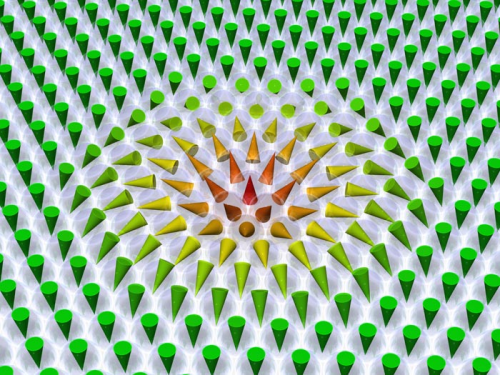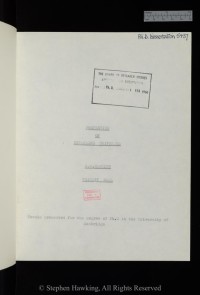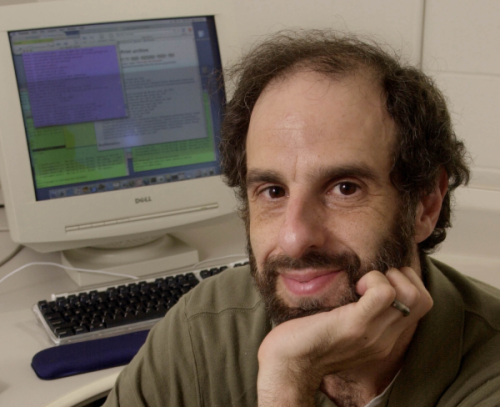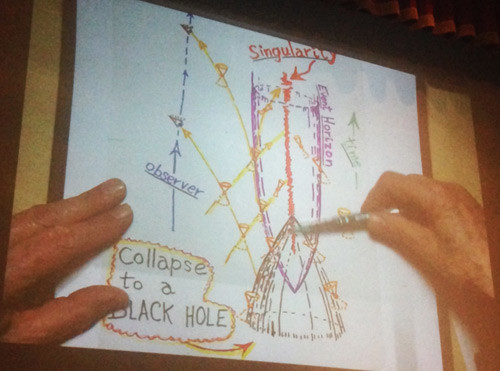Tag archives: Einstein
Happy Hedgehog Day, play like Einstein, Hawking could be in court over NHS

Magnetic hedgehog: illustration of a skyrmion (Courtesy: Wiesendanger Group, University of Hamburg)
By Michael Banks and Hamish Johnston
Today, people are celebrating Hedgehog Day – possibly as an alternative to Groundhog Day, which is a tradition in North America. There is a nice connection between the spiny critters and physics because diagrams illustrating magnetic quasiparticles called skyrmions are sometimes referred to as hedgehogs. This is because the magnetization associated with a skyrmion can resemble the spines of the hedgehog. The above image is from a news story about skyrmion research done by Kirsten von Bergmann, André Kubetzka and Roland Wiesendanger at the University of Hamburg.
View all posts by this author | View this author's profile
Hawking’s PhD thesis, Einstein letter up for auction, first zero
By Michael Banks

Courtesy: University of Cambridge
The PhD thesis of the University of Cambridge physicist Stephen Hawking was made freely available to read this week by the university’s Library’s Office of Scholarly Communication.
Hawking completed his PhD – entitled “Properties of expanding universes” – in 1966 when he was 24 years old. To mark Open Access Week 2017, the 117-page tome was posted on the university’s Apollo open-access repository, which is already home to some 15,000 research articles and 2400 theses.
Yet within hours of Hawking’s opus being posted online, demand was so great that the site crashed. However, according to the university, it was still downloaded more than 60,000 times in the first 24 hours.
“By making my PhD thesis open access, I hope to inspire people around the world to look up at the stars and not down at their feet,” Hawking noted. “Anyone, anywhere in the world should have free, unhindered access to not just my research, but to research of every great and enquiring mind across the spectrum of human understanding.”
View all posts by this author | View this author's profile
A glimpse of Einstein in Zurich

A Swiss view: Looking out over Zurich from the rooftop restaurant at ETH Zurich (Courtesy: Sarah Tesh)
By Sarah Tesh
Zurich is one of my favourite cities. Located in the north of Switzerland, it sits at the tip of a glistening, clear lake, with snow-topped mountains in the distance. The buildings are beautiful, the people are friendly and public transport is incredibly efficient. It is also home to multiple world-class science and technology institutes.
So when Physics World was invited to visit two of these facilities, I jumped at the chance to go. Our hosts for the trip were the international organization IBM Research, and ETH Zurich, a STEM-focused university, and the event was a showcase for some of their medical, computer science and quantum-computing research.
View all posts by this author | View this author's profile
A century ago Einstein sparked the notion of the laser

Another brilliant idea: laser beams illuminate fog. (CC BY 2.0/ Jeff Keyzer)
By Philip Ball
I just got back from having my broken wrist X-rayed (it’s doing fine, thanks), and noticed that a laser beam was used to position and align the X-ray source. Hardly the most sophisticated use of these optical devices, it’s true, but a little reminder that there’s probably hardly a day goes by in the life of an average urbanite without the laser’s beam of coherent photons impinging on it. From supermarket barcode scanning to broadband fibre-optic telecommunications, lasers are everywhere.
The fundamental idea behind this mainstay of modern life was published one hundred years ago by Albert Einstein. But blink and you’ll miss it in his seminal paper, “The quantum theory of radiation”, published in German in Physikalische Zeitschrift 18 121 (English translation here). Einstein is trying to work out what Max Planck’s “quantum hypothesis” – that the energy of an oscillator must take discrete values equal to some integer multiple of the oscillation frequency times a constant h – implies for the way light interacts with matter.
View all posts by this author | View this author's profile
Happy birthday Curiosity, overpaid footballers, cheeky Einstein photo sells
By Sarah Tesh, Hamish Johnston and Michael Banks
It’s Mars Curiosity’s 5th birthday tomorrow! The NASA rover touched down on 5 August 2012 and has been exploring the red planet ever since. It has travelled more than 10 miles, studied more than 600 vertical feet of rock and even proved that Mars was once habitable. While a Mars birthday party for Curiosity would be a lonely affair, researchers at NASA Goddard Space Flight Center have programmed the rover to sing “Happy birthday” to itself using its Sample Analysis at Mars (SAM) instrument. To introduce ground samples into the rover, SAM resonates through a range of frequencies, so the researchers programmed the instrument to run through the frequencies of the celebratory song.
View all posts by this author | View this author's profile
Einstein world record, Spider-Man physics, quantum films and cakes
By Sarah Tesh and James Dacey
A world-record-breaking hoard of Albert Einsteins invaded Toronto in Canada on Tuesday 28 March. 404 people gathered in the city’s MaRS Discovery District dressed in the genius’s quintessential blazer and tie, and sporting bushy white wigs and fluffy mustaches. As well as breaking the previous Guinness World Record of 99 Einsteins, the gathering kicked off this year’s Next Einstein Competition. The online contest invites the public to submit ideas that can make the world a better place and awards the winner $10,000 to help them realize it.
View all posts by this author | View this author's profile
Robots at arXiv, physicist runs for US president, Einstein emojis galore

Preprint pioneer: Paul Ginsparg in 2002, long before arXiv received 10,000 papers per month. (Courtesy: MacArthur Foundation)
By Hamish Johnston
Last month the arXiv preprint server received more than 10,000 papers – the first time in the history of the physics paper depository. While arXiv papers are not peer reviewed, they are checked to ensure that they are “of interest, relevance and value” to the scientific community – which arXiv promises to do within 24 h of submission. So how do they do it? Surely someone doesn’t read every word of every paper? The answer can be found in “What counts as science?”, which appears in Nautilus. arXiv was set up in 1991 by the physicist Paul Ginsparg, who explains how the service uses machine learning to sort the wheat from the chaff – something that has attracted controversy.
View all posts by this author | View this author's profile
Earth-gazing, a very noteworthy astronomer, chilling with Einstein and more

The Earth as seen by Himawari-8 earlier today. (Courtesy: JSA)
By Hamish Johnston
Who hasn’t wanted to float high above the Earth and gaze down on our planet as sunlight and clouds dapple across its surface. Thanks to the “Glittering Blue” animation, such views are not just for a privileged few astronauts. This stunning animation of one day’s observations from the Japanese weather satellite Himawari-8 has been put together by satellite-imagery analyst Charlie Lloyd. He has also included a nice FAQ page that explains some of the amazing phenomena captured by the satellite, including a huge tropical storm and the daily cloud cycles of a rainforest.
You can read more about Lloyd and the images in The Atlantic article “A New and Stunning Way to See the Whole Earth”. If you want to know what Himawari-8 is seeing right now, it has its own live webcam.
View all posts by this author | View this author's profile
The life and times of Einstein – ‘A vagabond and a wanderer’

Falling in: Sir Roger Penrose’s sketch of a black-hole collapse. (Courtesy: Tushna Commissariat)
By Tushna Commissariat
So much has been said about Einstein and his general theory of relativity (GR) that one would assume there isn’t two entire days worth of talks and lectures that could shed new light on both the man and his work. But that is precisely what happened last weekend at Queen Mary University London’s “Einstein’s Legacy: Celebrating 100 years of General Relativity” conference, where a mix of scientists, writers and journalists talked about everything from the “physiology of GR” to light cones and black holes, to M-theory and even GR’s “sociological spin-offs”.
The opening talk, “Not so sudden genius”, was given by journalist and author of “Einstein: A hundred years of relativity“, Andrew Robinson. The talk was very fascinating and early on Robinson outlined that Einstein stood on the shoulders of many scientists and not just “giants” such as Newton and Mach. But he also acknowledged that the scientist was always a bit of a loner and he preferred it this way. Robinson rightly pointed out that until 1907, Einstein was “working in brilliant obscurity” and later, even once fame found him, rootlessness really suited Einstein’s personality – he described himself as “a vagabond and a wanderer”.
Celebrating the centenary of Einstein’s general theory of relativity and asking what theorists have done lately
By Hamish Johnston
This week, people all over the world have been celebrating the 100th anniversary of Einstein’s general theory of relativity (GR). Einstein delivered his theory this week in November 1915. Not surprisingly, the Web has been buzzing with tributes to Einstein and explanations of his theory.
In the above video, the physicist Brian Greene and two young assistants demonstrate Einstein’s explanation of gravity using a huge piece of stretched Spandex. Why they have this Spandex ring in what appears to be their living room remains a mystery, but it and a large number of marbles do the trick when it comes to explaining GR.